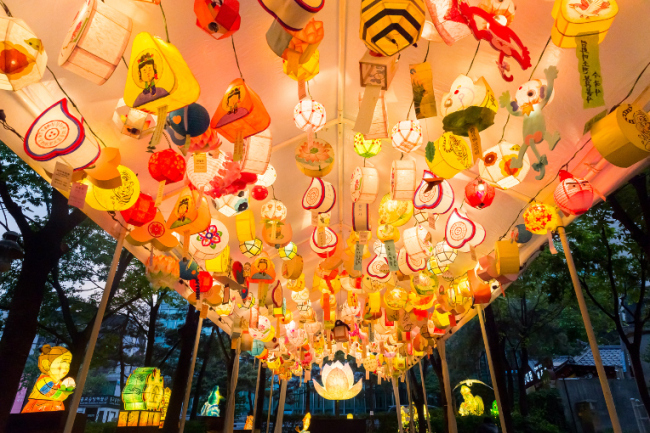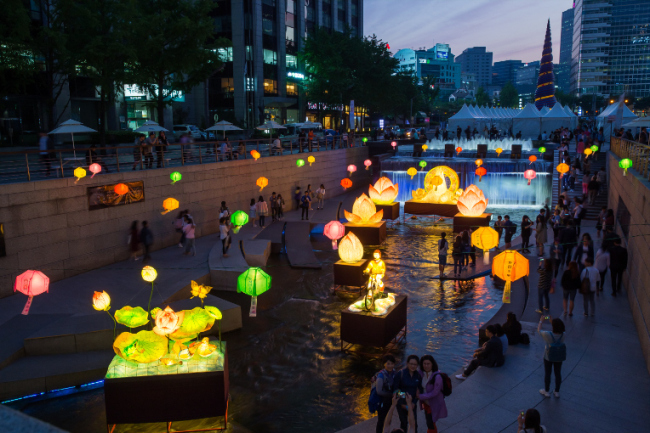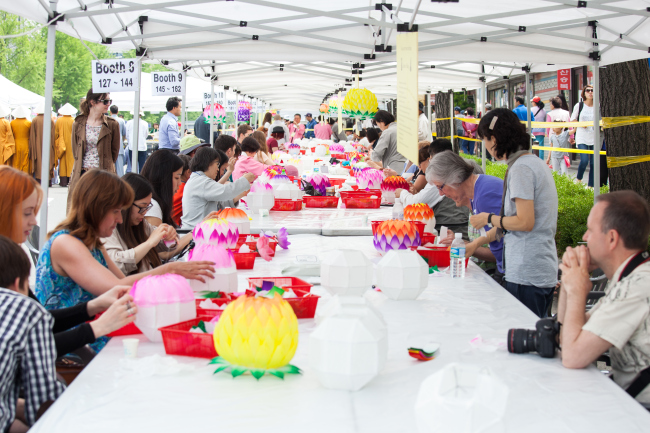The annual Yeondeunghoe, the lotus lantern festival, is set to light up Seoul streets to celebrate Buddha’s birthday falling on May 14 this year.
The festival, designated Korea’s Important Intangible Cultural Property No. 122, will take place at Jogyesa and Bongeunsa temples and along Jongno Street on May 6-8.
The origin of the three-day festival dates back to the Unified Silla era over 1,300 years ago, when the festival was held on Daeboreum, a day celebrating the first full moon of the lunar calendar. During the Goryeo Dynasty (918-1392), Yeondeunghoe turned into a festival marking Buddha’s birthday.
The festival, designated Korea’s Important Intangible Cultural Property No. 122, will take place at Jogyesa and Bongeunsa temples and along Jongno Street on May 6-8.
The origin of the three-day festival dates back to the Unified Silla era over 1,300 years ago, when the festival was held on Daeboreum, a day celebrating the first full moon of the lunar calendar. During the Goryeo Dynasty (918-1392), Yeondeunghoe turned into a festival marking Buddha’s birthday.

With the giant pagoda-shaped lantern in Gwanghwamun Square lit up on April 20 to signal the beginning of the festival, traditional lanterns crafted with Korean traditional mulberry paper, hanji, will be on display in Jongno and the vicinity.
Lanterns featuring lotus and other traditional figures and objects representing people’s wishes will be hung on the streets from April 30 to May 16, at 7 p.m. to 10 p.m. at Bongeunsa Temple, on May 6-22, from 6 p.m. to midnight at Jogyesa Temple, and on May 3-15, from 7 p.m. to 4 a.m. at Cheonggyecheon Stream.

On May 7, over 100,000 handcrafted lotus lanterns will cover the Jongno streets from Dongdaemun Gate to Jogyesa Temple at the lotus lantern parade taking place from 7 p.m. to 9:30 p.m.
Visitors can bring their own lantern to create the stream of light, along with 300 foreign tourists invited by Korea Tourism Organization and 2,000 foreigners who reserved their places in the parade in advance, following the parade at the end. Reserved seats at Pagoda Park for viewing the parade are available for foreigners.

At the post-parade celebration Hoehyang Hanmadang, a shower of flower petals and Ganggang Sullae, a Korean traditional group dance, will set the mood for reconciliation across borders, genders, ethnicities and religions.
On the last day, May 8, a vast array of traditional cultural events and performances will be held on the street in front of Jogyesa Temple from noon to 7 p.m. The Yeondeunghoe Preservation Committee has strengthened programs for the youth and families this year, the committee said in a press release.

There will be about 130 booths offering different programs including tasting of Korean temple cuisine, meditation, henna tattoo, as well as Korean folk plays and exhibitions with the theme of Buddhism. A crafts booth for foreigners to make their own lanterns will also be set up. At every booth, there will be English-speaking staff to assist foreigners.
Parade stand seats and spots for make-your-own lantern event can be reserved via International Dharma Instructors Association at ipogyo@buddhism.or.kr.
For more information, call (02) 2011-1744 or visit www.LLF.or.kr.
By Jung Eun-jin (jej2403@heraldcorp.com)







![[Weekender] How DDP emerged as an icon of Seoul](http://res.heraldm.com/phpwas/restmb_idxmake.php?idx=644&simg=/content/image/2024/04/25/20240425050915_0.jpg&u=)



![[KH Explains] No more 'Michael' at Kakao Games](http://res.heraldm.com/phpwas/restmb_idxmake.php?idx=644&simg=/content/image/2024/04/28/20240428050183_0.jpg&u=20240428180321)






![[Herald Interview] Mistakes turn into blessings in street performance, director says](http://res.heraldm.com/phpwas/restmb_idxmake.php?idx=652&simg=/content/image/2024/04/28/20240428050150_0.jpg&u=20240428174656)
